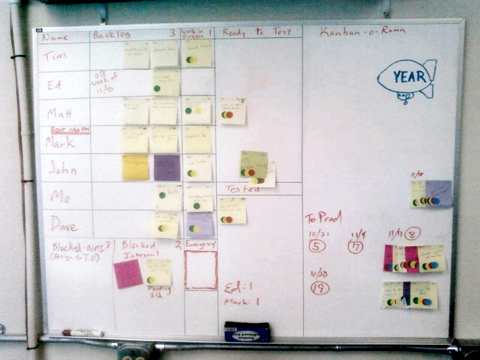Kanban-o-rama - Part 2
In part one I laid out the why and the how of our Kanban set up. In this part, a nice cell phone picture and some what it's done for us.
The Board

Here's our "borrowed" whiteboard. In stroke of genius from Mark, we drew the dividing lines with a Sharpie which makes them semi-permanent. One post-it note equals one work item, so for every post-it on the board there's a corresponding entry in our SharePoint work item list. Yellow post-its are regular priority items, purple tickets are high priority. (The stray colors are just strays...green == yellow, and fucia == purple.)
To the right of the names is where we start working with the tickets in the backlog column. It's sized to fit three tickets to help enforce our max three rule for that slot. Below that is the Blocked area, which isn't sized to scale of their respective max allowable tickets.
Moving to the right across the board is each developer's Work in Progress slot. Again, sized to enforce the max allowable items. This is where carried over our dotting strategy from the previous set-up: Yellow is domain understood, green is design understood and in dev, red is dev complete, blue is in production. (Though following this photo we have decided that blue will mean passed testing in staging, ready for production.)
At the bottom of the Work in Progress column is our Emergency slot. This is where our "drop everything" items end up. To our surprise, it hasn't been utilized as much as we thought it would.
To the right of the Work in Progress slot are our Ready for Test and Tested slots. These are the first real community slots on the board, and the honor system is in place for getting things tested. So far, so good on that.
The far right of the board is open space for notes, tracking what's gone into production, and blimp drawings.
What it has done for us
So far the big win for us has been gaining focus on one item at a time. We still have some growing to do in this area, as the inevitable "How long would it take to do X?" questions come up daily, and you find yourself looking at code you weren't aware existed when you started the day. So, we're trying to push harder to keep the distractions down, and keep the focus switching lessened.
Another thing that moving to this system has allowed is that it's much eaiser to report up the chain of command what each person is working on. It's much easier to manage expectations on when something will be finished and when another item will be started. Also, when the, "Item Q has to be done right away," request comes in I can say which items are being worked and ask which one should be stopped to pick up Item Q. Now that I can better articulate what each guy is doing, these requests are more often becoming, "Oh, this can wait until one of those is finished."
We've been using this for about four weeks now, and have had a few discussions around it. The early returns from the dev team is that they like it quite a bit. The numbers reflect that it's working, too, as we've closed more tickets over the last four weeks than we had in any four week period since mid-July.